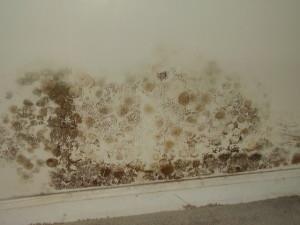
Mold is a fungal growth that is a natural part of the environment. It forms and spreads on different types of damp or decaying organic materials and can be found in both outdoor and indoor environments.
Mold is a necessary part of nature because it breaks down dead organic matter, but indoors, mold is a significant hazard to your home or workplace and possibly your health.
Mold in Your Home or Workplace
Once mold starts to grow, it spreads very quickly. It can look like a black stain, a furry growth, or green, brown, or yellow specks. As mold grows, it disperses microscopic seeds (mold spores) into the air, and these mold spores can be inhaled or ingested by people in the home or workplace.
Mold spores can also enter the HVAC system and spread throughout your home or workplace. The microscopic mold spores can cause infections, allergies, asthma, and other respiratory problems, as well as exacerbate existing medical conditions.
Mold needs two things to grow:
Possible Causes of Mold in Your Home or Workplace
Your home or workplace is at significant risk of growing mold in the following situations:
Humid Climates
Florida’s humid climate provides optimal conditions for mold to grow and thrive. Therefore, it is extremely important to maintain the indoor humidity inside your home or workplace below 60% with good air circulation to prevent humidity-driven mold growth. If your A/C unit is not working properly, or if the A/C thermostat is set too high or turned off altogether, the resulting high humidity can lead to a mold bloom inside your home or workplace. To avoid this, always set the fan on your A/C thermostat to “auto-fan” (not “manual” or “fan on”) and set the thermostat temperature no higher than 78°F. Additionally, leave interior doors open and run ceiling fans continuously to increase air circulation.
Leaking Pipes
Leaking plumbing drainpipes and water supply lines (such as to your refrigerator, dishwasher, and washing machine) can cause water losses that are often immediately apparent, but other times they are not and can cause moisture/water to build up inside walls or under flooring where it can’t be seen and goes unnoticed for a long period of time, causing significant damage and extensive mold growth.
HVAC Leaks
A blocked condensation drainpipe can cause significant damage and mold growth, not only to the area around your A/C handler but also adjacent rooms. Periodically, especially in the summer, pour bleach or vinegar down the condensation drainpipe to unclog slime buildup.
Leaking Roof
Roof leaks can be caused by severe weather, missing shingles, or even an aging roof which has lost its integrity over the years. It may not seem that serious, but even a small leak can cause mold to grow on the backside of your ceiling, in your attic. Minor leaks can be hard to detect until moisture stains appear on ceilings or musty odors become noticeable. It is important to address even small roof leaks as soon as possible before mold testing becomes necessary.
Condensation
Condensation occurs when cooler air contacts warmer surfaces. Condensation often occurs in the following areas of your home:
These areas should be cleaned and disinfected as needed. Also, increasing air circulation in these areas will have drying effect and will reduce, if not eliminate, the condensation from forming.
Poor Ventilation and Lack of Direct Sunlight
Proper ventilation helps remove excess moisture and enables fresh air to circulate around your home or workplace. Leaving interior doors open and continuously running ceiling fans will increase indoor air circulation. Additionally, opening blinds, curtains, and especially storm shutters will allow the UV light from the sun to kill mold and bacteria. Your home will also benefit from the drying effects of direct sunlight.
Prioritize Mold Prevention
The best way to avoid mold growth in your home is to create an environment that is adverse to it. For more practical mold prevention tips you can start implementing right away, please click here.
If you are concerned about mold in your home or workplace, interested in mold testing, or would like additional information, please contact Chuck at CFL Environmental Solutions. Chuck is a Florida Licensed Mold Inspector and a Certified Indoor Environmentalist, and he welcomes the opportunity to use his expertise and experience to be of service to you.